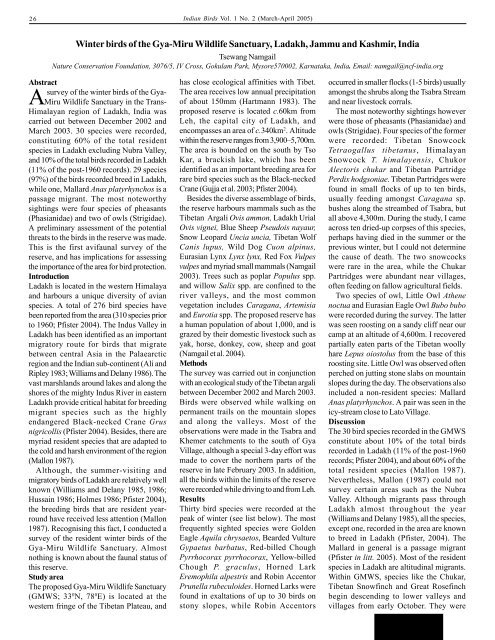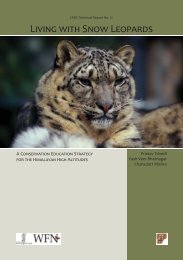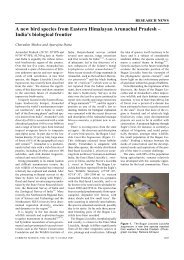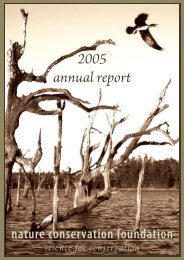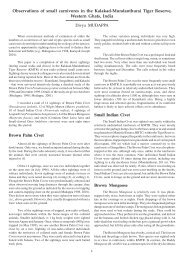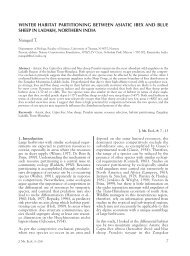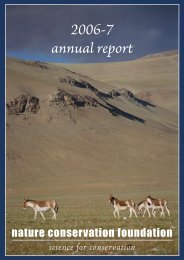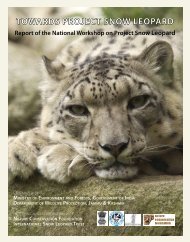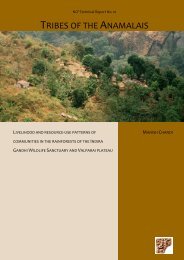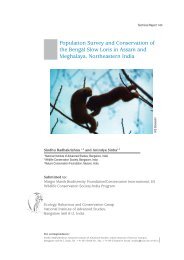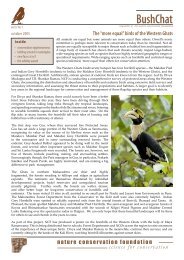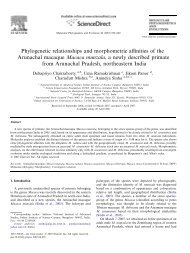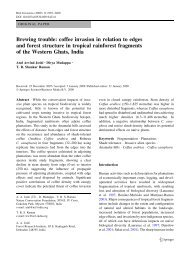Winter birds of the Gya-Miru Wildlife Sanctuary, Ladakh, Jammu and ...
Winter birds of the Gya-Miru Wildlife Sanctuary, Ladakh, Jammu and ...
Winter birds of the Gya-Miru Wildlife Sanctuary, Ladakh, Jammu and ...
You also want an ePaper? Increase the reach of your titles
YUMPU automatically turns print PDFs into web optimized ePapers that Google loves.
26<br />
Indian Birds Vol. 1 No. 2 (March-April 2005)<br />
<strong>Winter</strong> <strong>birds</strong> <strong>of</strong> <strong>the</strong> <strong>Gya</strong>-<strong>Miru</strong> <strong>Wildlife</strong> <strong>Sanctuary</strong>, <strong>Ladakh</strong>, <strong>Jammu</strong> <strong>and</strong> Kashmir, India<br />
Tsewang Namgail<br />
Nature Conservation Foundation, 3076/5, IV Cross, Gokulam Park, Mysore570002, Karnataka, India. Email: namgail@ncf-india.org<br />
Abstract<br />
Asurvey <strong>of</strong> <strong>the</strong> winter <strong>birds</strong> <strong>of</strong> <strong>the</strong> <strong>Gya</strong>-<br />
<strong>Miru</strong> <strong>Wildlife</strong> <strong>Sanctuary</strong> in <strong>the</strong> Trans-<br />
Himalayan region <strong>of</strong> <strong>Ladakh</strong>, India was<br />
carried out between December 2002 <strong>and</strong><br />
March 2003. 30 species were recorded,<br />
constituting 60% <strong>of</strong> <strong>the</strong> total resident<br />
species in <strong>Ladakh</strong> excluding Nubra Valley,<br />
<strong>and</strong> 10% <strong>of</strong> <strong>the</strong> total <strong>birds</strong> recorded in <strong>Ladakh</strong><br />
(11% <strong>of</strong> <strong>the</strong> post-1960 records). 29 species<br />
(97%) <strong>of</strong> <strong>the</strong> <strong>birds</strong> recorded breed in <strong>Ladakh</strong>,<br />
while one, Mallard Anas platyrhynchos is a<br />
passage migrant. The most noteworthy<br />
sightings were four species <strong>of</strong> pheasants<br />
(Phasianidae) <strong>and</strong> two <strong>of</strong> owls (Strigidae).<br />
A preliminary assessment <strong>of</strong> <strong>the</strong> potential<br />
threats to <strong>the</strong> <strong>birds</strong> in <strong>the</strong> reserve was made.<br />
This is <strong>the</strong> first avifaunal survey <strong>of</strong> <strong>the</strong><br />
reserve, <strong>and</strong> has implications for assessing<br />
<strong>the</strong> importance <strong>of</strong> <strong>the</strong> area for bird protection.<br />
Introduction<br />
<strong>Ladakh</strong> is located in <strong>the</strong> western Himalaya<br />
<strong>and</strong> harbours a unique diversity <strong>of</strong> avian<br />
species. A total <strong>of</strong> 276 bird species have<br />
been reported from <strong>the</strong> area (310 species prior<br />
to 1960; Pfister 2004). The Indus Valley in<br />
<strong>Ladakh</strong> has been identified as an important<br />
migratory route for <strong>birds</strong> that migrate<br />
between central Asia in <strong>the</strong> Palaearctic<br />
region <strong>and</strong> <strong>the</strong> Indian sub-continent (Ali <strong>and</strong><br />
Ripley 1983; Williams <strong>and</strong> Delany 1986). The<br />
vast marshl<strong>and</strong>s around lakes <strong>and</strong> along <strong>the</strong><br />
shores <strong>of</strong> <strong>the</strong> mighty Indus River in eastern<br />
<strong>Ladakh</strong> provide critical habitat for breeding<br />
migrant species such as <strong>the</strong> highly<br />
endangered Black-necked Crane Grus<br />
nigricollis (Pfister 2004). Besides, <strong>the</strong>re are<br />
myriad resident species that are adapted to<br />
<strong>the</strong> cold <strong>and</strong> harsh environment <strong>of</strong> <strong>the</strong> region<br />
(Mallon 1987).<br />
Although, <strong>the</strong> summer-visiting <strong>and</strong><br />
migratory <strong>birds</strong> <strong>of</strong> <strong>Ladakh</strong> are relatively well<br />
known (Williams <strong>and</strong> Delany 1985, 1986;<br />
Hussain 1986; Holmes 1986; Pfister 2004),<br />
<strong>the</strong> breeding <strong>birds</strong> that are resident yearround<br />
have received less attention (Mallon<br />
1987). Recognising this fact, I conducted a<br />
survey <strong>of</strong> <strong>the</strong> resident winter <strong>birds</strong> <strong>of</strong> <strong>the</strong><br />
<strong>Gya</strong>-<strong>Miru</strong> <strong>Wildlife</strong> <strong>Sanctuary</strong>. Almost<br />
nothing is known about <strong>the</strong> faunal status <strong>of</strong><br />
this reserve.<br />
Study area<br />
The proposed <strong>Gya</strong>-<strong>Miru</strong> <strong>Wildlife</strong> <strong>Sanctuary</strong><br />
(GMWS; 33 0 N, 78 0 E) is located at <strong>the</strong><br />
western fringe <strong>of</strong> <strong>the</strong> Tibetan Plateau, <strong>and</strong><br />
has close ecological affinities with Tibet.<br />
The area receives low annual precipitation<br />
<strong>of</strong> about 150mm (Hartmann 1983). The<br />
proposed reserve is located c.60km from<br />
Leh, <strong>the</strong> capital city <strong>of</strong> <strong>Ladakh</strong>, <strong>and</strong><br />
encompasses an area <strong>of</strong> c.340km 2 . Altitude<br />
within <strong>the</strong> reserve ranges from 3,900–5,700m.<br />
The area is bounded on <strong>the</strong> south by Tso<br />
Kar, a brackish lake, which has been<br />
identified as an important breeding area for<br />
rare bird species such as <strong>the</strong> Black-necked<br />
Crane (Gujja et al. 2003; Pfister 2004).<br />
Besides <strong>the</strong> diverse assemblage <strong>of</strong> <strong>birds</strong>,<br />
<strong>the</strong> reserve harbours mammals such as <strong>the</strong><br />
Tibetan Argali Ovis ammon, <strong>Ladakh</strong> Urial<br />
Ovis vignei, Blue Sheep Pseudois nayaur,<br />
Snow Leopard Uncia uncia, Tibetan Wolf<br />
Canis lupus, Wild Dog Cuon alpinus,<br />
Eurasian Lynx Lynx lynx, Red Fox Vulpes<br />
vulpes <strong>and</strong> myriad small mammals (Namgail<br />
2003). Trees such as poplar Populus spp.<br />
<strong>and</strong> willow Salix spp. are confined to <strong>the</strong><br />
river valleys, <strong>and</strong> <strong>the</strong> most common<br />
vegetation includes Caragana, Artemisia<br />
<strong>and</strong> Eurotia spp. The proposed reserve has<br />
a human population <strong>of</strong> about 1,000, <strong>and</strong> is<br />
grazed by <strong>the</strong>ir domestic livestock such as<br />
yak, horse, donkey, cow, sheep <strong>and</strong> goat<br />
(Namgail et al. 2004).<br />
Methods<br />
The survey was carried out in conjunction<br />
with an ecological study <strong>of</strong> <strong>the</strong> Tibetan argali<br />
between December 2002 <strong>and</strong> March 2003.<br />
Birds were observed while walking on<br />
permanent trails on <strong>the</strong> mountain slopes<br />
<strong>and</strong> along <strong>the</strong> valleys. Most <strong>of</strong> <strong>the</strong><br />
observations were made in <strong>the</strong> Tsabra <strong>and</strong><br />
Khemer catchments to <strong>the</strong> south <strong>of</strong> <strong>Gya</strong><br />
Village, although a special 3-day effort was<br />
made to cover <strong>the</strong> nor<strong>the</strong>rn parts <strong>of</strong> <strong>the</strong><br />
reserve in late February 2003. In addition,<br />
all <strong>the</strong> <strong>birds</strong> within <strong>the</strong> limits <strong>of</strong> <strong>the</strong> reserve<br />
were recorded while driving to <strong>and</strong> from Leh.<br />
Results<br />
Thirty bird species were recorded at <strong>the</strong><br />
peak <strong>of</strong> winter (see list below). The most<br />
frequently sighted species were Golden<br />
Eagle Aquila chrysaetos, Bearded Vulture<br />
Gypaetus barbatus, Red-billed Chough<br />
Pyrrhocorax pyrrhocorax, Yellow-billed<br />
Chough P. graculus, Horned Lark<br />
Eremophila alpestris <strong>and</strong> Robin Accentor<br />
Prunella rubeculoides. Horned Larks were<br />
found in exaltations <strong>of</strong> up to 30 <strong>birds</strong> on<br />
stony slopes, while Robin Accentors<br />
occurred in smaller flocks (1-5 <strong>birds</strong>) usually<br />
amongst <strong>the</strong> shrubs along <strong>the</strong> Tsabra Stream<br />
<strong>and</strong> near livestock corrals.<br />
The most noteworthy sightings however<br />
were those <strong>of</strong> pheasants (Phasianidae) <strong>and</strong><br />
owls (Strigidae). Four species <strong>of</strong> <strong>the</strong> former<br />
were recorded: Tibetan Snowcock<br />
Tetraogallus tibetanus, Himalayan<br />
Snowcock T. himalayensis, Chukor<br />
Alectoris chukar <strong>and</strong> Tibetan Partridge<br />
Perdix hodgsoniae. Tibetan Partridges were<br />
found in small flocks <strong>of</strong> up to ten <strong>birds</strong>,<br />
usually feeding amongst Caragana sp.<br />
bushes along <strong>the</strong> streambed <strong>of</strong> Tsabra, but<br />
all above 4,300m. During <strong>the</strong> study, I came<br />
across ten dried-up corpses <strong>of</strong> this species,<br />
perhaps having died in <strong>the</strong> summer or <strong>the</strong><br />
previous winter, but I could not determine<br />
<strong>the</strong> cause <strong>of</strong> death. The two snowcocks<br />
were rare in <strong>the</strong> area, while <strong>the</strong> Chukar<br />
Partridges were abundant near villages,<br />
<strong>of</strong>ten feeding on fallow agricultural fields.<br />
Two species <strong>of</strong> owl, Little Owl A<strong>the</strong>ne<br />
noctua <strong>and</strong> Eurasian Eagle Owl Bubo bubo<br />
were recorded during <strong>the</strong> survey. The latter<br />
was seen roosting on a s<strong>and</strong>y cliff near our<br />
camp at an altitude <strong>of</strong> 4,600m. I recovered<br />
partially eaten parts <strong>of</strong> <strong>the</strong> Tibetan woolly<br />
hare Lepus oiostolus from <strong>the</strong> base <strong>of</strong> this<br />
roosting site. Little Owl was observed <strong>of</strong>ten<br />
perched on jutting stone slabs on mountain<br />
slopes during <strong>the</strong> day. The observations also<br />
included a non-resident species: Mallard<br />
Anas platyrhynchos. A pair was seen in <strong>the</strong><br />
icy-stream close to Lato Village.<br />
Discussion<br />
The 30 bird species recorded in <strong>the</strong> GMWS<br />
constitute about 10% <strong>of</strong> <strong>the</strong> total <strong>birds</strong><br />
recorded in <strong>Ladakh</strong> (11% <strong>of</strong> <strong>the</strong> post-1960<br />
records; Pfister 2004), <strong>and</strong> about 60% <strong>of</strong> <strong>the</strong><br />
total resident species (Mallon 1987).<br />
Never<strong>the</strong>less, Mallon (1987) could not<br />
survey certain areas such as <strong>the</strong> Nubra<br />
Valley. Although migrants pass through<br />
<strong>Ladakh</strong> almost throughout <strong>the</strong> year<br />
(Williams <strong>and</strong> Delany 1985), all <strong>the</strong> species,<br />
except one, recorded in <strong>the</strong> area are known<br />
to breed in <strong>Ladakh</strong> (Pfister, 2004). The<br />
Mallard in general is a passage migrant<br />
(Pfister in litt. 2005). Most <strong>of</strong> <strong>the</strong> resident<br />
species in <strong>Ladakh</strong> are altitudinal migrants.<br />
Within GMWS, species like <strong>the</strong> Chukar,<br />
Tibetan Snowfinch <strong>and</strong> Great Rosefinch<br />
begin descending to lower valleys <strong>and</strong><br />
villages from early October. They were
observed in <strong>the</strong> villages during <strong>the</strong> winter<br />
survey, but were not seen near <strong>the</strong>se<br />
settlements during a summer visit.<br />
According to a popular belief, <strong>the</strong> Tibetan<br />
Snowfinch descending early is a harbinger<br />
<strong>of</strong> a severe winter.<br />
<strong>Gya</strong>-<strong>Miru</strong>, being a transition zone<br />
between <strong>the</strong> rugged mountains <strong>of</strong> central<br />
<strong>Ladakh</strong> in <strong>the</strong> west <strong>and</strong> <strong>the</strong> vast plains <strong>of</strong><br />
<strong>the</strong> Tibetan Plateau in <strong>the</strong> east, perhaps<br />
harbours a relatively high diversity <strong>of</strong> <strong>birds</strong>.<br />
A comprehensive survey in <strong>the</strong> area,<br />
encompassing different seasons will shed<br />
light on this aspect. In any case, it is one <strong>of</strong><br />
<strong>the</strong> few places in <strong>Ladakh</strong>, where both<br />
Himalayan <strong>and</strong> Tibetan snowcocks co-exist.<br />
The former is mostly restricted to western<br />
<strong>Ladakh</strong> <strong>and</strong> <strong>the</strong> latter to <strong>the</strong> eastern part<br />
(Pfister 2004). Fur<strong>the</strong>rmore, Tibetan<br />
Partridges were observed only in <strong>the</strong> Tsabra<br />
Catchment just to <strong>the</strong> south <strong>of</strong> <strong>the</strong> <strong>Gya</strong><br />
Village. Within Indian limits, <strong>the</strong> species is<br />
known to be restricted to eastern <strong>Ladakh</strong><br />
(Ali <strong>and</strong> Ripley 1974), <strong>and</strong> GMWS perhaps<br />
marks <strong>the</strong> western boundary <strong>of</strong> its<br />
distribution in <strong>Ladakh</strong>, as it was not seen<br />
fur<strong>the</strong>r west <strong>and</strong> below 4,000m (Mallon<br />
1987).<br />
Apart from <strong>the</strong> winter <strong>birds</strong>, <strong>the</strong> <strong>Gya</strong>-<strong>Miru</strong><br />
may also be important for migratory <strong>birds</strong>,<br />
as it has marshl<strong>and</strong>s especially along <strong>the</strong><br />
streams. Local people mentioned about an<br />
area in <strong>the</strong> nor<strong>the</strong>rn part <strong>of</strong> <strong>the</strong> GMWS where<br />
<strong>the</strong>y see Black-necked Crane. If true, this<br />
might add a new location to <strong>the</strong> list <strong>of</strong> areas,<br />
which <strong>the</strong> species visits in <strong>Ladakh</strong>.<br />
Never<strong>the</strong>less, one cannot rule out <strong>the</strong><br />
possibility that <strong>the</strong> local people were<br />
mistakenly referring to <strong>the</strong> Black Stork<br />
Ciconia nigra, which migrates through<br />
<strong>Ladakh</strong> (Pfister in litt. 2005).<br />
Potential threats to <strong>the</strong> <strong>birds</strong>: The death<br />
<strong>of</strong> <strong>the</strong> Tibetan Partridges could be attributed<br />
to two potential factors: severe winter <strong>and</strong>/<br />
or avian disease. According to <strong>the</strong> locals,<br />
<strong>the</strong> previous winter was mild, which leaves<br />
disease as a plausible cause for <strong>the</strong> deaths.<br />
Avian disease may be an important source<br />
<strong>of</strong> mortality <strong>of</strong> <strong>birds</strong> in <strong>Ladakh</strong> (during an<br />
ecological survey in <strong>the</strong> summer <strong>of</strong> 2004 in<br />
<strong>the</strong> Hanle River Basin, I came upon about<br />
50 corpses <strong>of</strong> Horned Lark; Namgail, unpubl.<br />
data). Such high mortality <strong>of</strong> <strong>birds</strong> in<br />
summer, when resources are abundant<br />
suggests <strong>of</strong> disease as an important cause<br />
<strong>of</strong> mortality. Such issues must be<br />
investigated immediately, as <strong>the</strong>re is a high<br />
chance <strong>of</strong> any disease spreading wide<br />
because <strong>of</strong> <strong>Ladakh</strong> being an important area<br />
Indian Birds Vol. 1 No. 2 (March-April 2005)<br />
for migratory <strong>birds</strong>.<br />
Secondly, <strong>the</strong> local people collect<br />
Caragana <strong>and</strong> Artemisia bushes for<br />
firewood during winter (Pers. obs.). The<br />
impact <strong>of</strong> such extractions on <strong>the</strong> area’s<br />
avian community is however not known. But<br />
it is possible that such activities affect <strong>the</strong><br />
population <strong>of</strong> <strong>birds</strong> such as <strong>the</strong> Tibetan<br />
Partridge that forage amongst <strong>the</strong> bushes<br />
along <strong>the</strong> streambed. Fur<strong>the</strong>rmore, <strong>the</strong><br />
reserve is grazed by c.8,000 domestic<br />
livestock, <strong>and</strong> <strong>the</strong> effect <strong>of</strong> livestock grazing,<br />
on <strong>birds</strong>, especially ground-nesting <strong>birds</strong><br />
needs to be researched.<br />
Apart from <strong>the</strong>se, <strong>the</strong> livestock herders<br />
despise <strong>the</strong> Golden Eagle as it occasionally<br />
lifts lambs <strong>and</strong> kids; seven such incidences<br />
were reported during <strong>the</strong> study period.<br />
However, no incidence <strong>of</strong> retaliation or<br />
persecution was reported from <strong>the</strong> area,<br />
unlike in <strong>the</strong> case <strong>of</strong> depredation by<br />
mammalian predators. Fur<strong>the</strong>rmore, <strong>the</strong><br />
Golden Eagle’s fea<strong>the</strong>rs are used to fletch<br />
traditional arrows. Since archery is a<br />
prominent sport amongst <strong>the</strong> <strong>Ladakh</strong>is,<br />
<strong>the</strong>re might be unreported incidences <strong>of</strong><br />
killing <strong>the</strong> bird for its fea<strong>the</strong>rs. For example,<br />
as per anecdotal information, <strong>the</strong> bird is<br />
occasionally killed for <strong>the</strong> purpose<br />
elsewhere in <strong>Ladakh</strong>, but no such<br />
incidences occurred in <strong>Gya</strong>-<strong>Miru</strong> (Tashi<br />
<strong>Gya</strong>tso, verbally, 2003). Finally, catching<br />
<strong>birds</strong> such as Chukar to supplement <strong>the</strong><br />
family larder was common in <strong>the</strong> past, but is<br />
currently discouraged due to <strong>the</strong><br />
implementation <strong>of</strong> conservation laws.<br />
Acknowledgements<br />
The International Snow Leopard Trust, <strong>the</strong><br />
<strong>Wildlife</strong> Protection Society <strong>of</strong> India <strong>and</strong> <strong>the</strong><br />
University <strong>of</strong> Tromso – <strong>Wildlife</strong> Institute <strong>of</strong><br />
India Institutional Cooperation Program,<br />
funded <strong>the</strong> study. I express my sincere<br />
gratitude to Dr Otto Pfister for his valuable<br />
comments on <strong>the</strong> manuscript, <strong>and</strong> for<br />
identifying <strong>the</strong> Himalayan Eagle Owl. I also<br />
thank Dr T.R. Shankar Raman for his critical<br />
comments on <strong>the</strong> manuscript. Thanks are<br />
also due to Mr Jigmet Takpa <strong>and</strong> Mr Salim<br />
Ulhaq, Department <strong>of</strong> <strong>Wildlife</strong> Protection<br />
Leh for granting permission to work in <strong>the</strong><br />
area. Messrs. Thinles Dorjey, Tashi <strong>Gya</strong>tso<br />
<strong>and</strong> Thinles Yangjor are also thankfully<br />
acknowledged for <strong>the</strong>ir field assistance in<br />
tough winter conditions.<br />
References<br />
Ali, Salim <strong>and</strong> S. D. Ripley. 1983. H<strong>and</strong>book <strong>of</strong><br />
<strong>the</strong> <strong>birds</strong> <strong>of</strong> India <strong>and</strong> Pakistan toge<strong>the</strong>r with<br />
those <strong>of</strong> Bangladesh, Nepal, Bhutan <strong>and</strong><br />
Ceylon. 10 vols. Bombay: Oxford University<br />
Press.<br />
27<br />
Grimmett, R., C. Inskipp & T. Inskipp. 1999.<br />
Pocket guide to <strong>the</strong> <strong>birds</strong> <strong>of</strong> <strong>the</strong> Indian<br />
subcontinent. New Delhi: Oxford University<br />
Press.<br />
Gujja, B., A. Chatterjee, P. Gautam & P. Ch<strong>and</strong>an.<br />
2003. Wetl<strong>and</strong>s <strong>and</strong> lakes at <strong>the</strong> top <strong>of</strong> <strong>the</strong><br />
world. Mountain Research <strong>and</strong> Development<br />
23: 219-221.<br />
Hartmann, H. 1983. Pflanzengesells-chaften<br />
entlang der Kashmirroute in <strong>Ladakh</strong>. Jb. Ver.<br />
Schutz der Bergwelt, 131-37.<br />
Holmes, P. R. 1986. The avifauna <strong>of</strong> <strong>the</strong> Suru<br />
River Valley, <strong>Ladakh</strong>. Forktail 2: 21-41.<br />
Hussain, S. A. 1986. Status <strong>of</strong> Black-necked<br />
Crane in <strong>Ladakh</strong>. Problems <strong>and</strong> prospects. J.<br />
Bombay Nat. Hist. Soc. 82: 449-458.<br />
Mallon, D. P. 1987. The winter <strong>birds</strong> <strong>of</strong> <strong>Ladakh</strong>.<br />
Forktail 3: 27-41.<br />
Namgail, T. 2003. <strong>Gya</strong>-<strong>Miru</strong>: last refuge <strong>of</strong> <strong>the</strong><br />
endangered Tibetan argali. <strong>Sanctuary</strong> Asia 23:<br />
16-21.<br />
Namgail, T., J. L. Fox & Y. V. Bhatnagar. 2004.<br />
Argali <strong>and</strong> livestock: friends or foes? Nature<br />
<strong>of</strong> interaction between argali <strong>and</strong> domestic<br />
sheep <strong>and</strong> goats in a prospective Trans-<br />
Himalayan wildlife reserve. Techincal Report<br />
submitted to <strong>the</strong> International Snow Leopard<br />
Trust, Seattle.<br />
Pfister, O. 2004. Birds <strong>and</strong> mammals <strong>of</strong> <strong>Ladakh</strong>.<br />
New Delhi: Oxford University Press.<br />
Williams, C. <strong>and</strong> S. Delany. 1985. Migration<br />
through <strong>the</strong> Northwest Himalaya - some results<br />
<strong>of</strong> <strong>the</strong> Southampton University <strong>Ladakh</strong><br />
Expeditions, Part 1. Bull. O.B.C. 2: 10-14.<br />
Williams, C. <strong>and</strong> S. Delany. 1986. Migration<br />
through <strong>the</strong> Northwest Himalaya - some results<br />
<strong>of</strong> <strong>the</strong> Southampton University <strong>Ladakh</strong><br />
Expeditions, Part 2. Bull. O.B.C. 3: 11-16.<br />
List <strong>of</strong> winter <strong>birds</strong> observed between<br />
December 2002 <strong>and</strong> March 2003 in <strong>the</strong><br />
proposed <strong>Gya</strong>-<strong>Miru</strong> <strong>Wildlife</strong> <strong>Sanctuary</strong>,<br />
<strong>Ladakh</strong>, India.<br />
Mallard Anas platyrhynchos Lato, PM*.<br />
Golden Eagle Aquila chrysaetos: Khemer, R.<br />
Himalayan Griffon Gyps himalayensis:Puyul,<br />
R*.<br />
Bearded Vulture Gypaetus barbatus Khemer, R.<br />
Common Kestrel Falco tinnunculus: Nilung, SV*.<br />
Tibetan Snowcock Tetraogallus tibetanus Fidpo,<br />
R*.<br />
Himalayan Snowcock Tetraogallus himalayensis<br />
Paktse, R*.<br />
Chukor Alectoris chukar <strong>Gya</strong>, R.<br />
Tibetan Partridge Perdix hodgsoniae Paktse, R.<br />
Rock Pigeon Columba livia <strong>Gya</strong>, R.<br />
Hill Pigeon Columba rupestris <strong>Gya</strong>, R.<br />
Snow Pigeon Columba leuconota <strong>Miru</strong>, R*.<br />
Eurasian Eagle-Owl Bubo bubo Paktse, R.<br />
Little Owl A<strong>the</strong>ne noctua Fidpo, R*.<br />
Horned Lark Eremophila alpestris: Tsabra, R.<br />
Robin Accentor Prunella rubeculoides Paktse,<br />
R.<br />
Brown Accentor Prunella fulvescens <strong>Miru</strong>, R*.<br />
White-throated Dipper Cinclus cinclus Lato, R*.
28<br />
Indian Birds Vol. 1 No. 2 (March-April 2005)<br />
Guldenstadt’s Redstart Phoenicurus<br />
erythrogaster <strong>Miru</strong>, R*.<br />
Fire-fronted Serin Serinus pusillus Puyul, R*.<br />
Black-headed Mountain-Finch Leucosticte<br />
br<strong>and</strong>ti Ngayul, R*.<br />
Mongolian Finch Bucanetes mongolicus <strong>Miru</strong>,<br />
R.<br />
Common Great Rosefinch Carpodacus rubicilla<br />
Nilung, R.<br />
House Sparrow Passer domesticus <strong>Gya</strong>, R.<br />
Tibetan Snowfinch Montifringilla adamsi<br />
Kotsang, R.<br />
Black-billed Magpie Pica pica: <strong>Miru</strong>, R.<br />
Red-billed Chough Pyrrhocorax pyrrhocorax:<br />
Khemer, R.<br />
Yellow-billed Chough Pyrrhocorax graculus:<br />
Tsabra, R.<br />
Carrion Crow Corvus corone: <strong>Miru</strong>, R*.<br />
Common Raven Corvus corax: Khemer, R*.<br />
R=resident.<br />
SV=summer visitor.<br />
PM=passage migrant.<br />
* Seen on less than five occasions.<br />
a<br />
Location <strong>of</strong> <strong>the</strong> first sighting.<br />
Birds seen on a trek in <strong>the</strong> Chanshal Pass, Himachal Pradesh<br />
V. Santharam<br />
Institute <strong>of</strong> Bird Studies & Natural History, Rishi Valley 517 352, Andhra Pradesh, India. Email: <strong>birds</strong>@rishivalley.org<br />
Trekking has never been my cup <strong>of</strong> tea<br />
<strong>and</strong> I was in two minds when I agreed<br />
to accompany <strong>the</strong> Rishi Valley School team,<br />
which ran short <strong>of</strong> an escort to go with <strong>the</strong><br />
students on a trek to <strong>the</strong> Pabbar Valley in<br />
Himachal Pradesh. In two minds because I<br />
always felt that I may not be able to actively<br />
pursue my interest in <strong>birds</strong> while on a trek<br />
where one was expected to walk a predetermined<br />
distance each day <strong>and</strong> also as I<br />
was not sure if I would be able to keep pace<br />
with <strong>the</strong> more energetic children. But on <strong>the</strong><br />
o<strong>the</strong>r h<strong>and</strong>, I had <strong>the</strong> whole vacation ahead<br />
<strong>of</strong> me with nothing planned out <strong>and</strong> <strong>the</strong><br />
prospect <strong>of</strong> baking in <strong>the</strong> summer heat <strong>of</strong><br />
Chennai loomed large. The trek promised a<br />
lot <strong>of</strong> snow <strong>and</strong> freezing temperatures. So<br />
why not take a chance? Better to freeze than<br />
bake, I thought. Now, in retrospect, I feel<br />
my choice was a wise one as I came back<br />
from <strong>the</strong> trek refreshed with a lot <strong>of</strong> wonderful<br />
memories <strong>and</strong> experiences <strong>and</strong> also with a<br />
lot <strong>of</strong> interesting <strong>birds</strong> on my list. I also<br />
realized that I was not as bad a trekker as I<br />
had been rating myself!<br />
Ok, why did I title this piece a trek to<br />
Chanshal Pass whereas I am writing about<br />
Pabbar Valley trek? The answer is simple.<br />
The trek was to Chanshal Pass (4,220m) <strong>and</strong><br />
beyond <strong>and</strong> <strong>the</strong> base camp was at Larot. To<br />
reach this, one had to take <strong>the</strong> road from<br />
Shimla going to Chirgaon via Kufri,<br />
Karapathar, Jubbal, Hatkoti, <strong>and</strong> Rohru, a<br />
distance <strong>of</strong> over 150km, due east <strong>of</strong> Shimla.<br />
The last 30km or so <strong>of</strong> <strong>the</strong> bus journey<br />
passes through <strong>the</strong> Pabbar Valley <strong>and</strong> in fact<br />
<strong>the</strong> road goes all along <strong>the</strong> Pabbar River. So<br />
we did pass through <strong>the</strong> Pabbar Valley but<br />
we went trekking up along <strong>the</strong> higher<br />
reaches. Our trek took us to <strong>the</strong> Uttaranchal<br />
border.<br />
The journey commenced in Delhi on <strong>the</strong><br />
hot afternoon <strong>of</strong> 18.iv.2004. We, a group <strong>of</strong><br />
22 students <strong>and</strong> two teachers, took a<br />
chartered bus from ISBT area <strong>and</strong><br />
proceeded to Larot. The 17-hour journey<br />
was uneventful <strong>and</strong> somewhat tiring. But<br />
by dawn <strong>the</strong> next morning, I began my vigil<br />
for <strong>birds</strong> <strong>and</strong> managed to see quite a few<br />
before reaching our destination. The bus<br />
was traversing through a mixed habitat <strong>of</strong><br />
tall forest – mostly coniferous – <strong>and</strong><br />
scattered settlements with orchards <strong>of</strong> apple<br />
<strong>and</strong> o<strong>the</strong>r fruit trees along a steep hillside.<br />
As <strong>the</strong> bus passed along <strong>the</strong> Pabbar River,<br />
more <strong>birds</strong> could be noticed. Several Brown<br />
Dippers Cinclus pallasii were noticed<br />
perched or flying over <strong>the</strong> waters below us.<br />
At regular interval <strong>the</strong>re were White-capped<br />
Chaimarrornis leucocephalus <strong>and</strong><br />
Plumbeous Redstarts Rhyacornis<br />
fuliginosus, also on <strong>the</strong> riverside rocks.<br />
The last leg took us across <strong>the</strong> river <strong>and</strong><br />
up a hill, a good climb <strong>of</strong> some 1,500m or so.<br />
The vegetation changed to a more<br />
temperate type with conifer trees, <strong>and</strong> it<br />
became cooler. There were orchards <strong>and</strong><br />
scattered houses. The road was bumpy <strong>and</strong><br />
dusty. The road we had travelled all along<br />
<strong>the</strong> river now showed as a ribbon far below<br />
us <strong>and</strong> <strong>the</strong> denuded hillside bore marks <strong>of</strong> a<br />
couple major l<strong>and</strong>slides in <strong>the</strong> not too<br />
distant past. Above us, <strong>the</strong> skies were clear<br />
<strong>and</strong> blue <strong>and</strong> <strong>the</strong>re were hilltops with traces<br />
<strong>of</strong> snow on <strong>the</strong>ir tops. Eventually we<br />
reached <strong>the</strong> base camp, a three-storey<br />
building made <strong>of</strong> wood atop <strong>the</strong> hill <strong>of</strong>fering<br />
good views all around. As we climbed down,<br />
we felt refreshed by <strong>the</strong> views <strong>and</strong> <strong>the</strong> clear<br />
mountain air.<br />
The day was meant for acclimatization as<br />
we were already at 2,500m <strong>and</strong> over <strong>the</strong> next<br />
week we were to touch 4,200m. After a wash<br />
<strong>and</strong> breakfast I went around familiarizing<br />
myself with <strong>the</strong> <strong>birds</strong>. Immediately around<br />
<strong>the</strong> camp, I could see a few <strong>birds</strong> <strong>and</strong> also<br />
heard several – some <strong>of</strong> which I was able to<br />
identify based on my earlier experiences.<br />
Grey Bushchat Saxicola ferrea was <strong>the</strong> most<br />
conspicuous bird in <strong>the</strong> vicinity. The<br />
Common Cuckoo Cuculus canorus was<br />
heard calling <strong>and</strong> on occasions <strong>the</strong> male was<br />
seen perched on an exposed perch with<br />
wings drooped as it sang. A lovely bird that<br />
caught my attention was <strong>the</strong> Rock Bunting<br />
Emberiza cia. That evening we had a taste<br />
<strong>of</strong> what <strong>the</strong> trek was going to be as we<br />
panted uphill on an uneven, rock-strewn<br />
track through <strong>the</strong> tiny village.<br />
On 20 th morning, we set <strong>of</strong>f after breakfast<br />
on <strong>the</strong> first leg <strong>of</strong> <strong>the</strong> trek. We could clearly<br />
witness <strong>the</strong> rampant clearing <strong>of</strong> <strong>the</strong> forest –<br />
tree felling by burning <strong>of</strong> trees at <strong>the</strong> base<br />
to weaken <strong>the</strong>m <strong>and</strong> later claiming <strong>the</strong>m as<br />
fallen wood all along. We noticed flocks <strong>of</strong><br />
sheep herded uphill for grazing in <strong>the</strong> alpine<br />
pastures. We climbed over 800m that<br />
morning, <strong>the</strong> trail being steep in places <strong>and</strong><br />
gradual in certain stretches. We took about<br />
4½ hours to cover <strong>the</strong> 5km distance.<br />
Towards <strong>the</strong> end, we were passing through<br />
a continuous forest stretch. The campsite<br />
at Maduie was in a forest clearing. The<br />
forest was open, comprising mostly Deodar<br />
trees <strong>and</strong> occasional maple or o<strong>the</strong>r<br />
hardwood trees. There was no undergrowth<br />
except along streams that carried snowmelt.<br />
Rhododendron clumps were now common<br />
in open meadows <strong>and</strong> <strong>the</strong>y were coming into<br />
bloom with <strong>the</strong>ir purplish pink/blue flowers.<br />
That evening <strong>the</strong>re was snowfall <strong>and</strong> rains<br />
in <strong>the</strong> neighbourhood <strong>and</strong> <strong>the</strong> night<br />
temperatures plummeted.<br />
I was a free <strong>the</strong> next day <strong>and</strong> so while<br />
o<strong>the</strong>rs went exploring <strong>the</strong> hill behind <strong>the</strong><br />
camp, I went around looking for <strong>birds</strong>. The<br />
bird life was not very rich ei<strong>the</strong>r in terms <strong>of</strong><br />
number or variety but never<strong>the</strong>less proved<br />
interesting for me as I saw several ‘lifers’.<br />
On <strong>the</strong> morning <strong>of</strong> <strong>the</strong> 22 nd we trekked to<br />
<strong>the</strong> highest point <strong>of</strong> <strong>the</strong> trek – <strong>the</strong> Chanshal<br />
Pass. This involved an initial steep climb<br />
along stony streambeds till we crossed <strong>the</strong><br />
treeline <strong>and</strong> reached <strong>the</strong> open meadows. A<br />
few flowers were beginning to appear in <strong>the</strong><br />
o<strong>the</strong>rwise seemingly sterile l<strong>and</strong>scape. At<br />
<strong>the</strong> end <strong>of</strong> <strong>the</strong> open meadow overlooking<br />
<strong>the</strong> deep valley over 1500m in depth stood a


